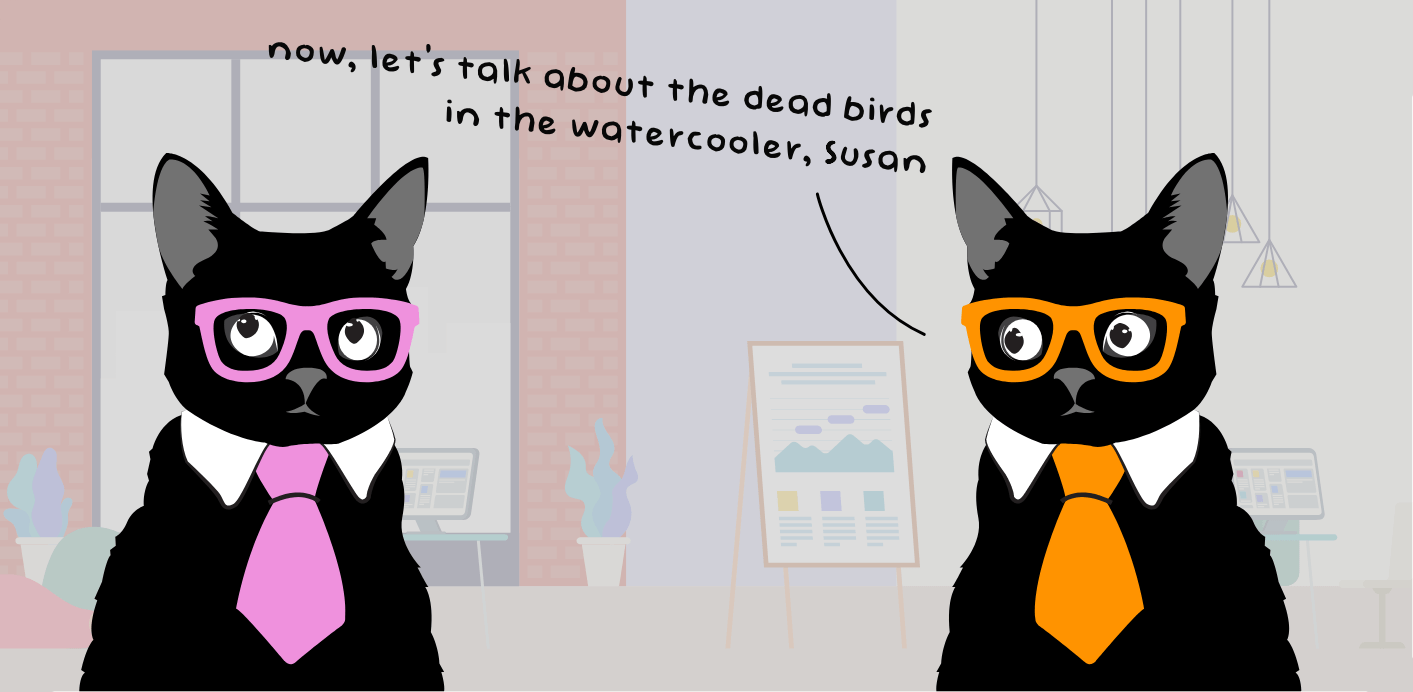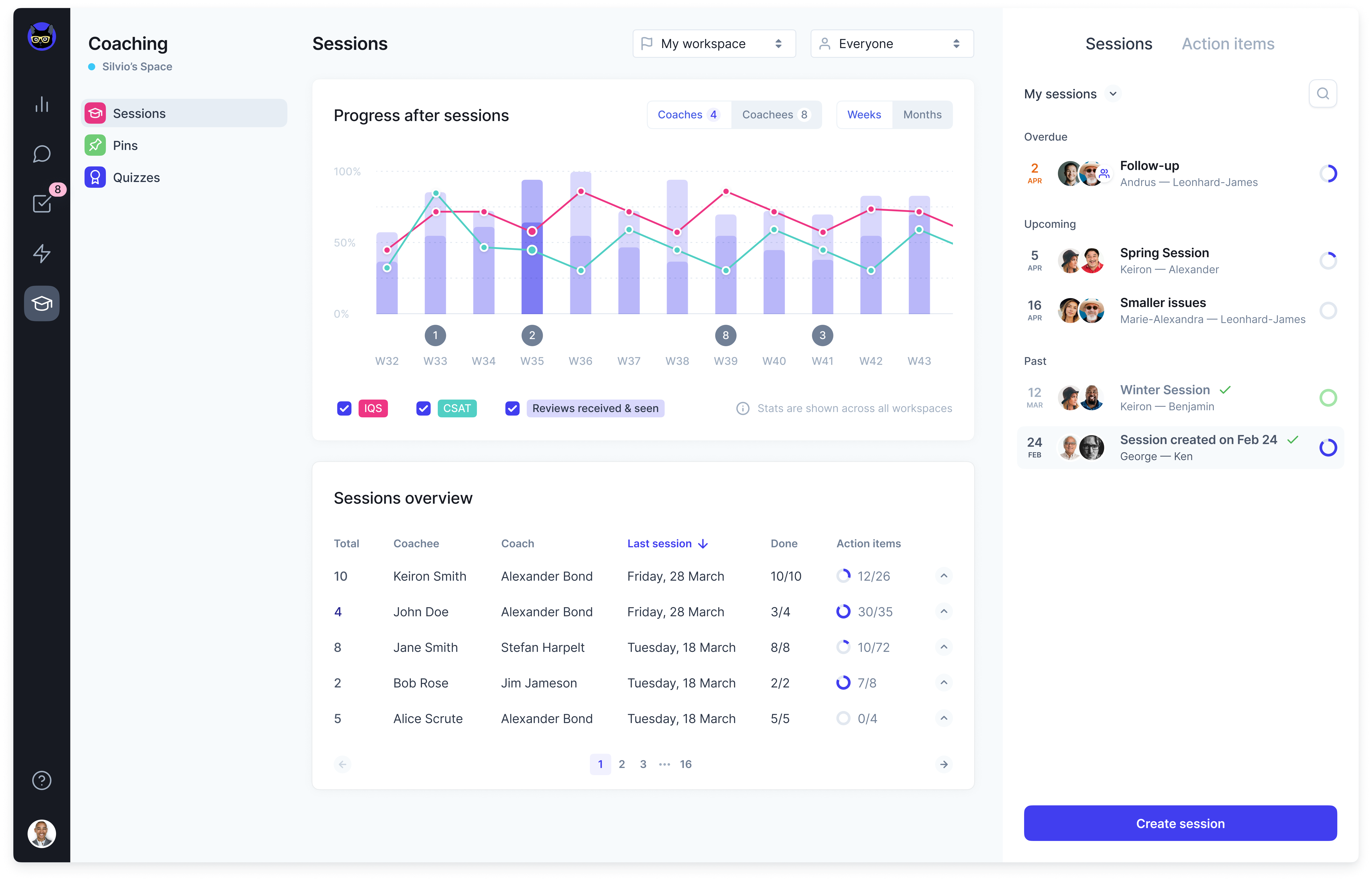Customer service performance reviews can be an intimidating part of a support leader’s responsibilities.
But they’re an essential part of your responsibilities. They’re a great opportunity to:
- Highlight the strengths and opportunities of your team members.
- Align individual goals and metrics to the wider company.
- Engage your employees by tying in career development.
Here’s how to conduct customer service performance reviews in a way that’s valuable for your team.
What is a customer service performance review?
A customer service performance review is a structured assessment that involves a manager evaluating their individual team member’s performance and often includes an employee self-review as well.
Managers typically evaluate their team’s performance and provide feedback on what they did well and what opportunities they have. At most companies, formal customer service employee evaluation is done annually, but many customer support leaders do semiannual or even quarterly customer service performance reviews to evaluate their team’s progress.

How to evaluate customer service performance
Assessing customer service quality involves more than just a whisker’s worth of metrics. Most leads use a range of these in their employee performance reviews, such as:
- Internal Quality Score (IQS). Internal quality scores are a way to measure how well agents meet the quality standards that you set. They often provide a more complete picture of someone’s performance.
- Customer Satisfaction (CSAT). CSAT is an external rating that provides the customer perspective. While CSAT ratings typically include some noise (sometimes people rate the product or process, not the service), great customer service agents often have high CSAT.
- Other feedback surveys, like NPS. Feedback surveys always have the same bias that CSAT does by including other factors influencing a customer’s rating but if NPS or CES are more important metrics for your business, it makes sense to work with them instead.
- Response times, e.g. FRT. While response times don’t exist in a vacuum (if you have a backlog, everyone across the team will have slower response times), they’re good at highlighting discrepancies between different agents’ workloads or potential time management issues.
- First Contract Resolution (FCR) or average replies. More minor metrics like these can be used if there’s a massive (unexplained) difference between agents. Typically if you have a great QA process, you’ll catch any of the issues brought up with additional metrics like these.
![]()
There are usually three levels of performance evaluation ratings that a customer service representative could fall into:
- Exceeds expectations
- Meets expectations
- Needs improvement
Some organizations even add two additional customer service performance rating levels to bookend the standard three: “exceptional” is above “exceeds expectations” and “does not meet expectations” is below “needs improvement.”
To work with metrics well, you need to understand which metrics are essential for your business, why, and what benchmarks you’re aiming for.
Customer service metrics provide a great starting point for a performance review but that’s all they do. You should still dig extensively into individual cases and feedback to pull out specific guidance that will be helpful to your customer service representatives.
![]()
How to conduct a customer service performance review
Conducting a great performance review is as easy as teaching a cat to fetch — it takes some time.
There are two main steps to it:
- The preparation before the meeting.
- Delivering feedback during a meeting.
In an ideal scenario, your team members should walk out of the review feeling motivated, confident, and connected to your vision for them. That starts with investing time in crafting the feedback you want to give them.
Tips for covering both steps well include:
- Encourage self-reflection in advance.
- Combine qualitative and quantitative data.
- Set clear expectations for the meeting.
- Recognize achievements.
- Provide constructive feedback (without the compliment sandwich!).
- Deliver the conversation with empathy.

Encourage self-reflection
Self-review notes help you identify how employees view themselves and their work. They can give you insight into how they view their performance and if you’ve been setting expectations properly throughout the year. It shouldn’t be a surprise to your customer service team members how they’re performing when review season arrives.
Combine qualitative and quantitative data
Be transparent about the metrics you use to assess their performance.
Ideally, you’d be reviewing these weekly or monthly anyway. A good tip is to share these in a spreadsheet to review them and highlight trends easily.
But metrics still only provide part of the picture. The rest of the picture comes from their impact on others in the team, any other projects they work on, or other contributions they have.
Set clear expectations for the meeting
Customer service performance reviews are notoriously uncomfortable. Share an agenda in advance with your team members, explain to them what you’ll be talking about, and try to take any uncertainty out of it.
Recognize achievements
These meetings are an opportunity to celebrate successes (and progress), as well as to highlight opportunities for improvement.
Make sure you dedicate a good amount of time to the things that are going well. For example, if one of your employees struggled with reaching the individual CSAT goal at the beginning of the year, recognizing progress can be a huge motivator.
Avoid the compliment sandwich
Trying to sugarcoat constructive feedback and avoiding difficult conversations is doing your direct reports a disservice.
An example of sugarcoating is the compliment sandwich. The compliment sandwich is when you “sandwich” negative feedback between two pieces of positive feedback. It causes confusion by either making the positive feedback seem disingenuous or the negative feedback to be missed entirely.
Deliver the conversation with empathy
Leading with empathy will change the way your team receives both positive and negative feedback. Empathy comes down to how you communicate. As Brené Brown says in her book, Dare to Lead, “Clear is kind.”
Empathy takes into consideration both business needs and your employee’s personal needs.
- Take the time to type out a script if you want to deliver feedback in a considered and planned way.
- Tie your positive feedback to business and personal goals, so your team members understand how their achievements contribute to the bigger picture.
- Acknowledge challenges that they might be facing or blockers that they were able to overcome.
- Give them time to process constructive feedback and provide detailed examples so they understand where you’re coming from.
- Guide them by providing direction and helping them figure out where their growth opportunities are.
Employee performance evaluation phrases for customer service
How you communicate in a performance evaluation is even more important than what you communicate.
To help, here are some examples of customer service performance review phrases for both positive feedback and constructive feedback.
Positive feedback performance review phrases
Positive feedback is most effective when you’re specific about what team members did well.
- “Thanks for all the work you did with [insert project here]! It helped decrease the time it takes to resolve customer issues by X% [or X days/business hours].”
- “You’ve done a great job this year at making sure your handle times are down without sacrificing the quality of your work. Nice job!”
- “The interaction you had with our customer in [explain situation] showed an incredible aptitude for empathy and going above and beyond. And that perfectly aligns with our company value of [company value name]. Incredible work here!”
- “You have exceptional customer service skills and great communication skills! You give customers the information they need and don’t leave anything ambiguous so they trust you, and by extension, our support team and company.”
- “Your work with our cross-functional team that implemented [insert project] has helped pave the way for a better customer support experience. You put our customers first and were an advocate for our team. Thank you!”
- “Your metrics across the board exceed customer expectations. Thank you for being such a role model to the rest of the team.”

Constructive feedback performance review phrases
These examples focus on the opportunity and the impact it will have on customers:
- “There’s an opportunity to improve your customer communication. This is a situation where it’s better to apologize, show empathy, and provide more information.”
- “Your tickets tend to stay open too long, and our customers depend on fast resolution from us. Let’s work together on a plan to help your time management and any other roadblocks that may be preventing you from closing your cases quickly.”
- “You close a lot of tickets which is great. Your quality is lacking in [insert specific area]. It’s worth slowing down a bit to make sure we’re giving correct information to our customers and resolving their issue completely.”
- “Your individual CSAT scores are showing that our customers frequently struggle with how you handle [insert specific area]. Since customer satisfaction is important, let’s work on meeting those expectations over the next three months.”
- “Your tone in phone calls can be a bit abrupt and to the point. Try and be a little more conversational and warm to create a better customer support experience. It’ll help our customers feel welcome when they call.”

What to write in a customer service performance review
This is a rough format and structure for a performance review. You can use this both while conducting the meeting and preparing for it. Feel free to adapt this structure based on your team and company.
A typical performance review will cover these sections:
- An introduction explaining the purpose of the meeting and the agenda.
- Performance rating. Whether your agent is meeting customer expectations, exceeding them, or demonstrating exceptional performance, being direct at the beginning helps them orient themselves and understand how you perceive their work.
- Employee metrics. Go through their metrics and discuss any trends that stand out.
- Strengths. Highlight several strengths your direct report displays. It’s often great to touch on how those strengths contribute to the business and their personal career growth.
- Opportunities. Pick the two or three most impactful opportunities they have and work with them on a plan on how to improve here.
- Conclusion. Conclude with the next steps for opportunities as well as the customer service performance review process for your organization. Salary reviews are typically part of the performance review. You can include that either with the performance rating or at the end.

Example of a written performance review
Here’s what it looks like all put together for an employee named Sally.
Intro:
Sally has been an asset to the customer support team in 2023. This review will highlight some of her many strengths, help guide her in some opportunities for 2024, and serve as a starting point for 2024.
Performance rating:
Sally is a great employee and does a great job within her defined support role. Her performance rating for 2023 is “meets expectations.” She is engaged, puts her best foot forward in her role, and occasionally seeks out projects to help her grow.
Strengths:
Sally has many strengths. Her biggest strengths in her role are the quality of her communication and her ability to prioritize our customer’s issues well.
Sally’s communication is incredible with our customers. She gives out enough information to explain the issue without confusing the customer. Her communications are warm and welcoming, which displays an eagerness and pleasure in helping our customers. She also follows up well.
Her follow-up and follow-through are equally a highlight of her strength of prioritization. She comes across issues both big and small and does a really nice job managing her time to get to both in a way to ensure customer satisfaction. And when she isn’t able to solve an issue right away, she follows up to make sure the customer knows they’re not forgotten.
Opportunities:
Sally does a great job with her given role, but to get to the next level, I’d like to see her start to proactively go above and beyond. 2023 was about ramping up in her current role and 2024 will be dedicated to getting her to the next level.
Sally has opportunities in two key areas. First, I’d like to see her proactively seek out ways to improve our department. She is great at recognizing opportunities. I’d like to see her bring up solutions to those opportunities in 2024.
The second area, which will also help her identify potential solutions for opportunities she sees, is to offer up her work time when projects come up. Not only will the company benefit from her expertise when projects arise, but this will also provide growth opportunities she can use to further her career here.
Conclusion:
Sally’s performance over 2023 has been great to watch. She’s become an integral part of the customer support team and has proven herself a leader in her role. As she continues her career, the two opportunities I’ve outlined will help her level up her career here. Sally’s grown a ton over the past year and I’m looking forward to seeing what 2024 will bring!
Performance reviews highlight opportunities
Customer service performance reviews can create an amazing environment for your team, as long as they’re done well.
One of the best ways to provide meaningful recognition and highlight opportunities is by having good data to back it up. Zendesk QA (formerly Klaus) is a tool that combines internal quality reviews with customer feedback for a full picture of how your employees are doing.

You can use it as a coaching tool for your team to highlight their strengths and opportunities, not just during review time, but throughout the entire year.


